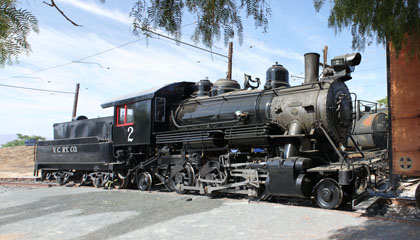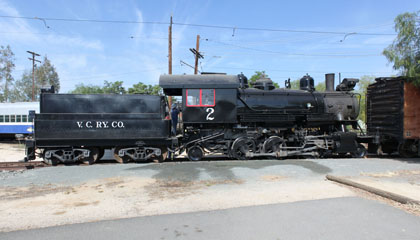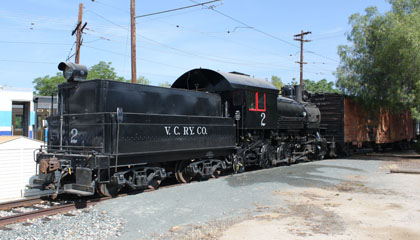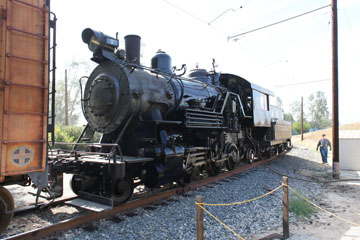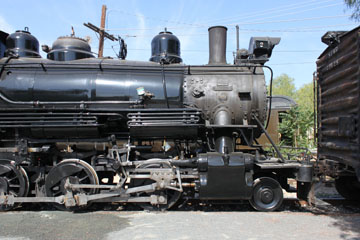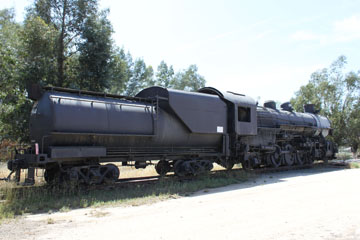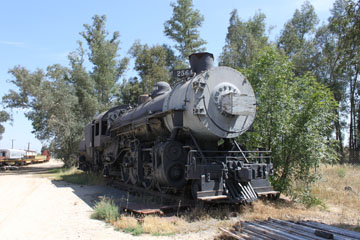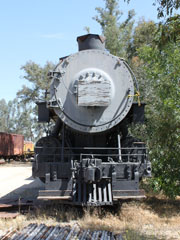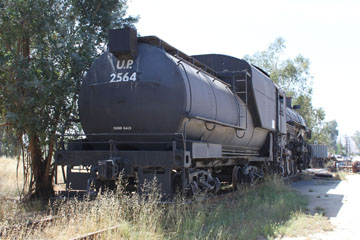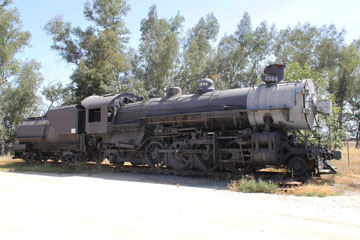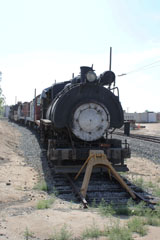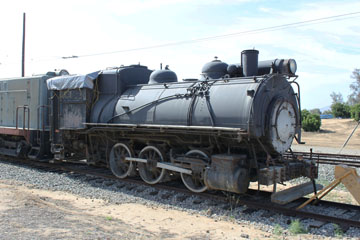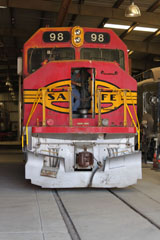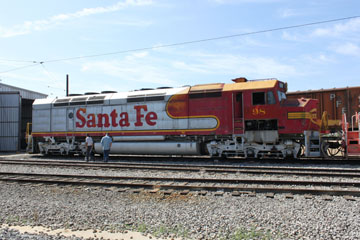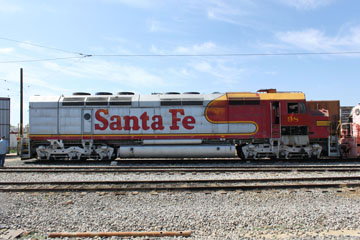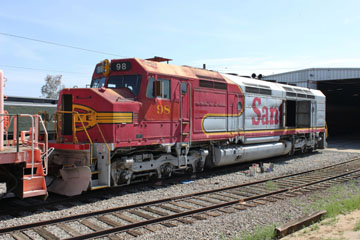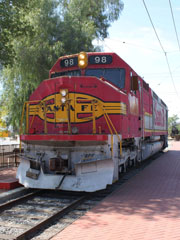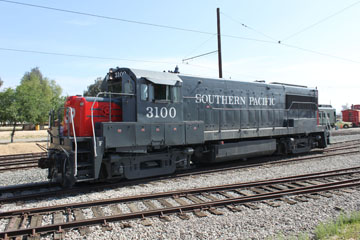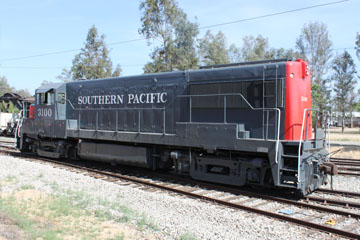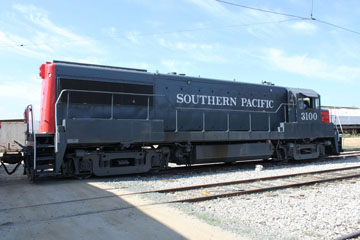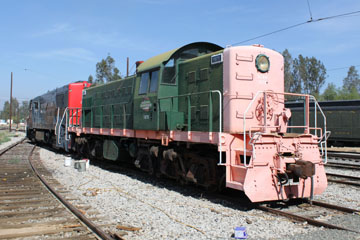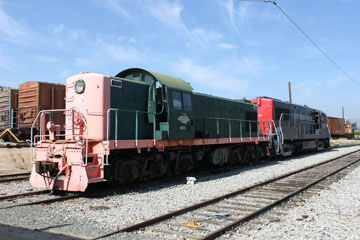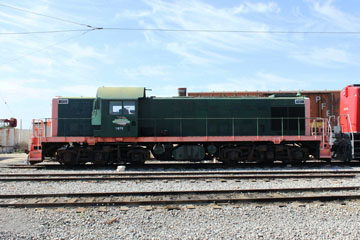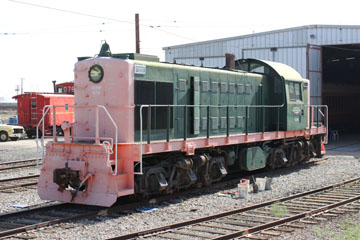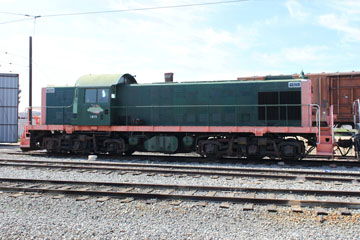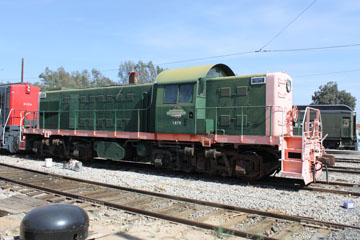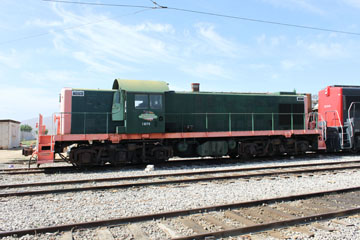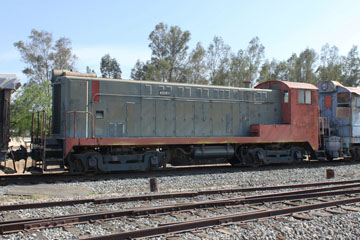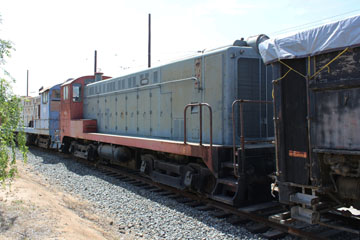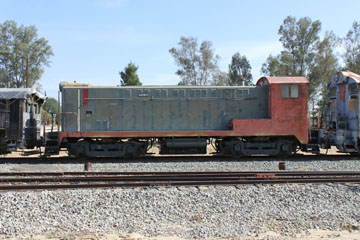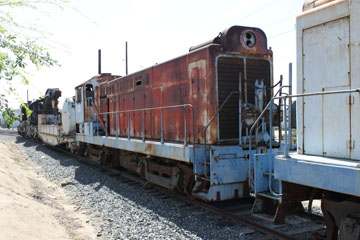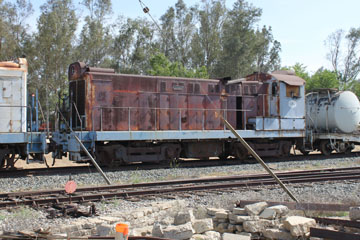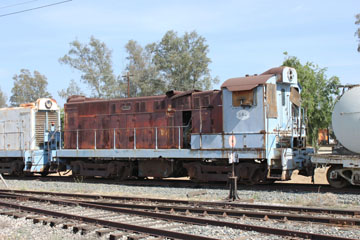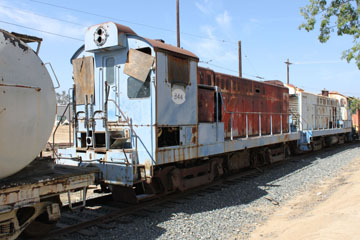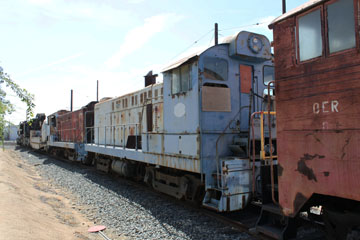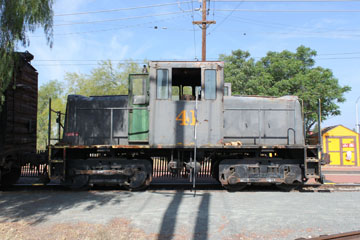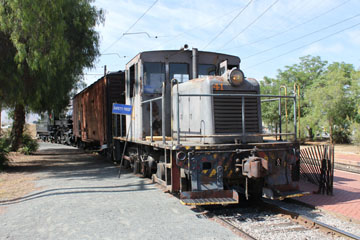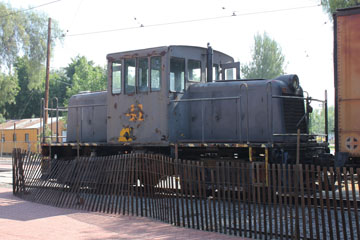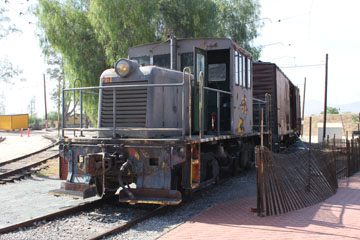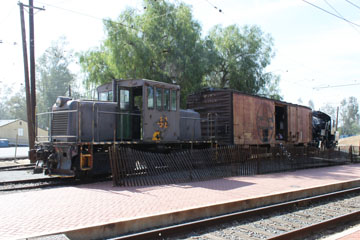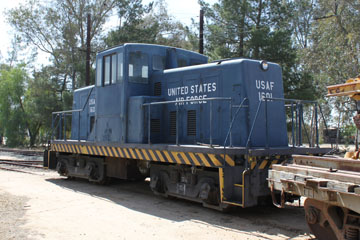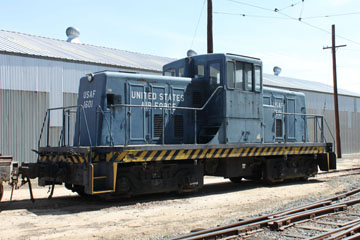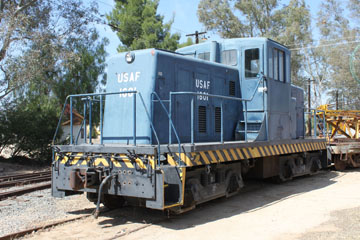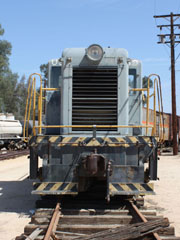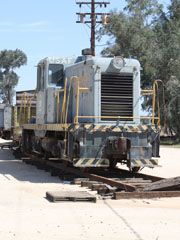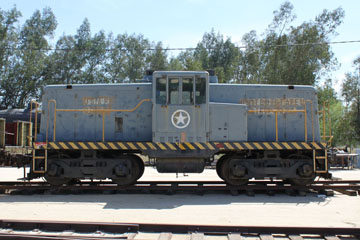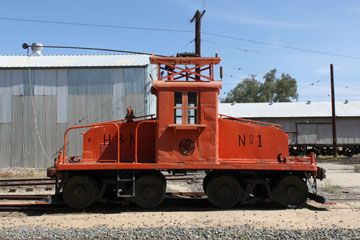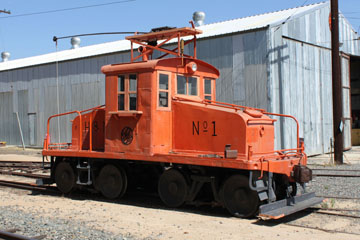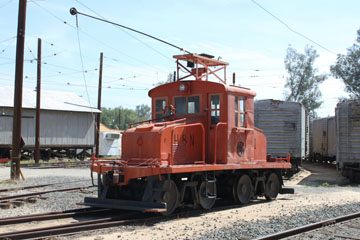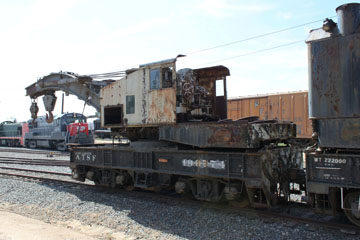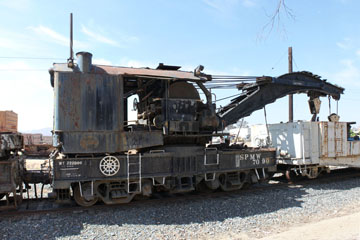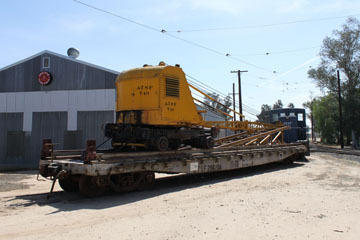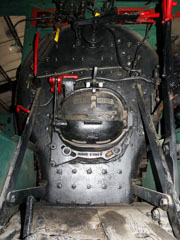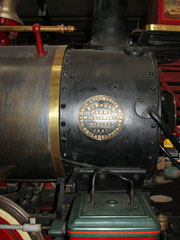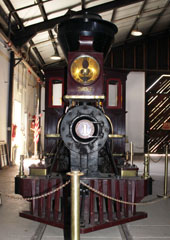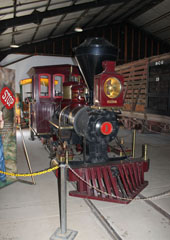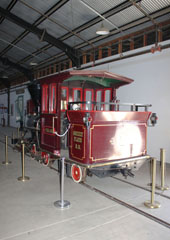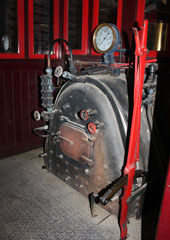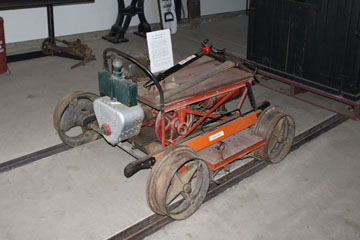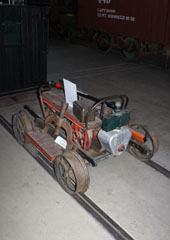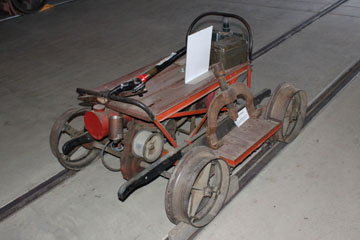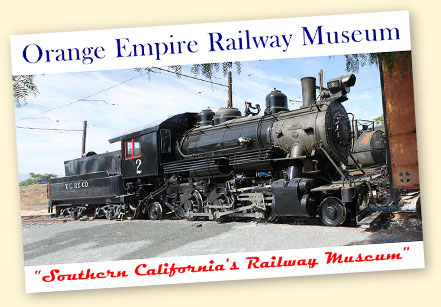

The Orange Empire Railway Museum, now known as the Southern California Railway Museum, is located at 2201 South A Street in Perris, CA, at Pinacate Station. It was founded in 1956 as the Orange Empire Trolley Museum to collect and maintain the Pacific Electric Red Cars, which were then disappearing from service.
The equipment was originally kept at Travel Town but shortage of space occasioned a move to the current
location in 1958 (you can see photos of Travel Town on this website). After the move, the museum began collecting other railroad related artefacts and began to focus on Southern California’s railroad history more broadly. It now has over two hundred historic railway cars and locomotives, as well as the largest collection of Pacific Electric Railway rolling stock in the world.
The museum grounds are open every day from 9.00 am to 5.00 pm other than on Thanksgiving and Christmas, and admission is free. There are operating trolleys every
weekend and on most major holidays between 11.00 am and 5.00 pm. The steam locomotive Ventura County #2 normally operates on the third weekend of the month from September to May as well as during certain special events and major holidays.

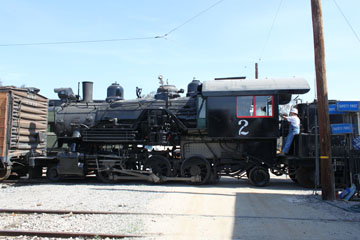
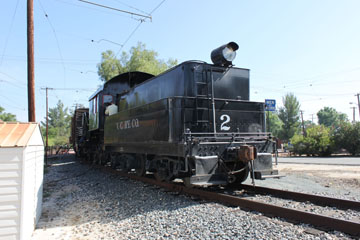
This Prairie type locomotive (2-6-2) was built by Baldwin in 1922 as #107 for the Cascade Timber Co., in Reliance, WA. Cascade Timber ceased operations in 1942 and #107 was sold to the Ventura County Railway, which connected the Naval Construction Battalion supply base at Port Hueneme, CA, with the Southern Pacific Railroad at Oxnard.
Renumbered #2, the locomotive underwent some modifications, including a water tank extension on the tender and reinforcement of the old arch-bar tender trucks.
#2 was sent to Southern Pacific’s Bayshore Shops near San Francisco in 1947, overhauled and extensively rebuilt, including replacing the worn out wooden cab with a salvaged metal one. It retired some time in the 1950s and was placed into storage.
It then went through a couple of private owners and steamed occasionally in the late 1950s and early 1960s and, for the last time at Port Hueneme in February 1972. In November 1973, after sale to the museum, it was shipped to Perris on two flatcars.
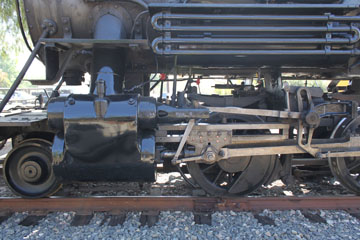
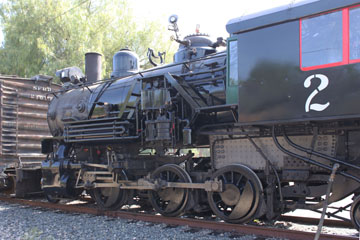
Except during periods of repair and overhaul, #2 has been in service at the museum ever since. When I visited, it had just undergone a major overhaul and was being air pressure tested.
#2 was built as a coal burner and may also have burned wood while working at Cascade Timber. It was subsequently converted to an oil burner (the tender has a capacity of 3,000 gallons of oil). The engine weighs 132,270 lbs, 101,300 lbs on its 44” drivers. With 17” x 24” cylinders, it operates at a boiler pressure of 175 psi delivering 23,400 lbs tractive effort.
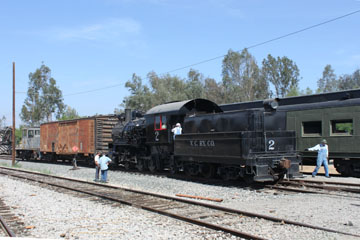
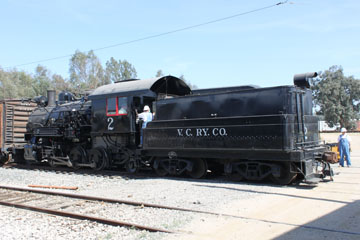

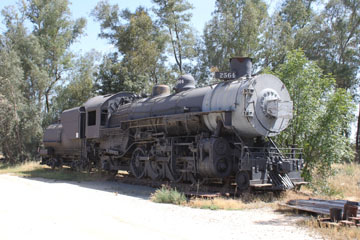
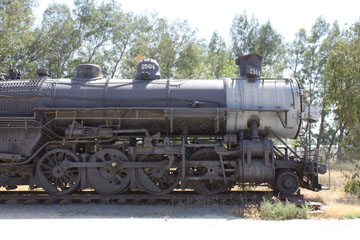
In the early 1940s, #2564 was rebuilt and fitted
with Boxpok disc main drivers, improved main rods and a modified smoke box with a new “Sweeney” stack.
The “Sweeney” stack was the product of UP’s experimentation with different front end drafting arrangements starting in 1936. They were designed to produce draft with less back pressure by increasing the size of the nozzles. As a result, the exhaust steam velocity increased, and a taller stack was needed to fill the stack evenly with a continuous vacuum.
#2564 is the last of three hundred and sixty-two
2-8-2 Mikado type locomotives bought by the Union Pacific. It was one of a batch of ten Class MK-10 built by Alco in 1921 (#2555-#2564).
Produced for UP subsidiary, the Los Angeles & Salt Lake, as #3725 it was renumbered #2725 in 1922, and operated on the east end of the line between Salt Lake City, UT, and Caliente, NV. In 1923, it moved to another UP subsidiary, the Oregon Short Line, where it was renumbered #2564 and spent the next forty-eight years hauling passenger and freight trains.
In 1996, a modernisation of the park forced the removal of the locomotive and it was acquired by the museum. In 1997, after months of preparation, the engine and tender were loaded onto large flatcars and transported to Perris. The locomotive has since been stabilised to minimise deterioration while it is stored outdoors.
A coal burner, #2654 has a 70 sq ft grate, 242 sq ft firebox and total heating surface of 5,128 sq ft, including 912 sq ft of superheating. It operated at a boiler pressure of 210 psi delivering 51,076 lbs tractive effort.
By the 1950s, #2564 had been relegated to short-haul freight and seasonal yard switching.
Around 1955, the locomotive went into storage in Pocatello, ID, where it stayed until donated to a historical foundation in 1959 and placed on display in a park in Oro Grande, CA.
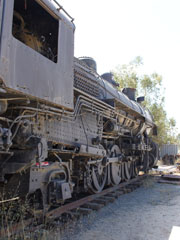
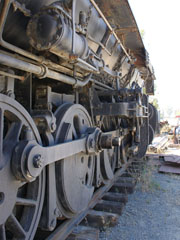
The engine weighs 282,800 lbs, 219,400 lbs on its 63” drivers and has 26” x 28” cylinders and Walschaert valve gear (the valve gear has been removed while #2564 is awaiting restoration).
You can see another UP 2-8-2 on the UP #2295 page of this website.

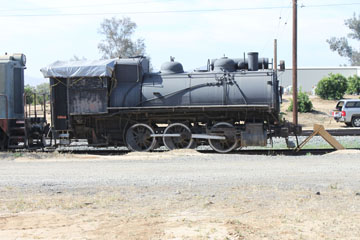
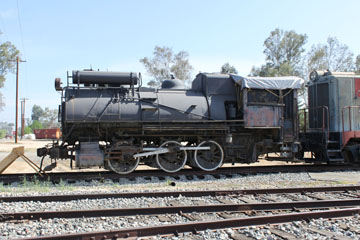
#2 is an 0-6-0T Saddle Tank locomotive built for the Mojave Northern in 1917 by the Davenport Locomotive Works in Davenport, IA.
The Mojave Northern was later taken over by Southwest Portland Cement and is, today, still part of successor CEMEX.
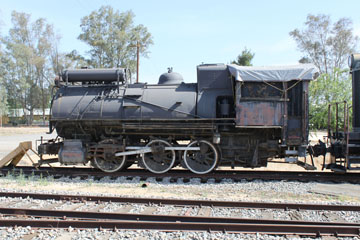
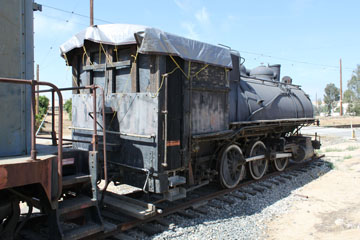
In 1966, #2 was donated by Southwest Portland Cement to the California Southern Railroad Museum. The CRSM leased the right of way through Perris and the two organisations worked side by side until they amalgamated in 1975 to form the Orange Empire Museum.
#2 weighs 118,000 lbs. An oil burner with 46” drivers and 17” x 24” cylinders, it operated at a boiler pressure of 150 psi delivering 19,218 lbs tractive effort. You can see another Mojave Northern 0-6-0T, #3, on the Pacific Southwest Railway Museum page of this website.

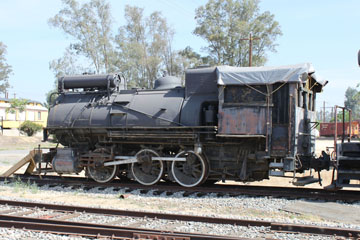

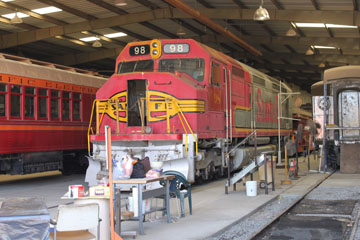
Above and left, ATSF EMD FP45 #98 was in the main engine shed being prepared for service when I arrived at the museum.
Below, #98 is pulled out of the shed by SP #3100 with OERM #1975 in tow (#3100 and #1975 are shown later on this page).
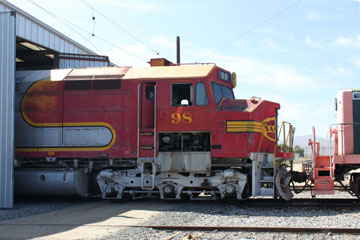
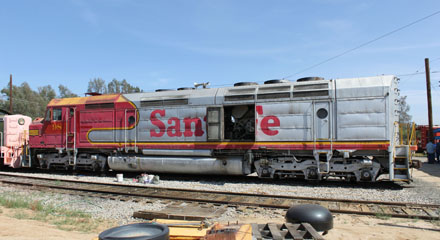
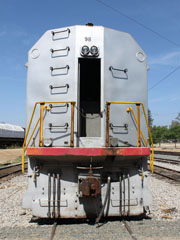
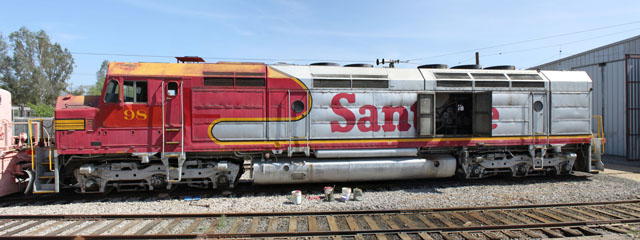
Left, above and right, although a little faded, the Santa Fe “Warbonnet” makes #98 a handsome sight in the morning sun.
The red, yellow and silver livery was developed for the AT&SF’s passenger E-units by EMD in the 1930s. After the war, it was applied to the railroad’s FT, F3, F7 and Alco PA units, and has continued sporadically up until today on some modern BNSF heritage units.
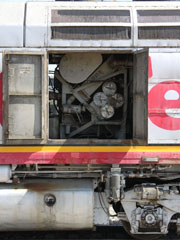
The FP45 has a 645E3 20 cylinder prime mover powering a GM-D32 generator to drive four GM-D77 traction motors, one on each axle. Weighing 360,000 lbs and 72' 4" long, it produced starting tractive effort of 90,000 lbs at 25% and 82,100 lbs continuous tractive effort at 16.1 mph with a top speed of 65 mph.
Nine FP45s were built from 1967 to 1968, for the AT&SF (#100-#108), which did not want its prestigious Super Chief and other passenger trains pulled by hood units with external walkways. Five more were bought by the Milwaukee Road
(#1-#5).
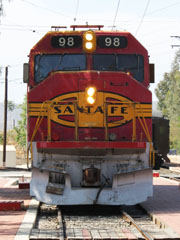
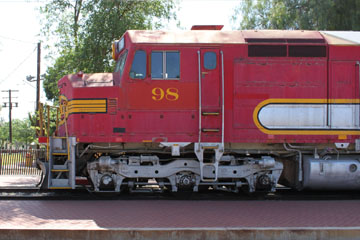
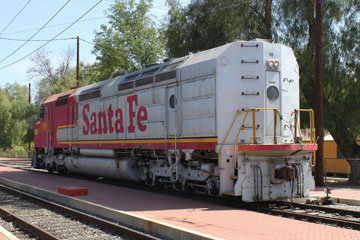

#98 was delivered as ATSF #108 in December 1967, the last FP45 bought by the Santa Fe. It was renumbered #5948 in 1970 as part of a general renumbering.
Like the rest of the FP45s, #5948 was assigned to freight after Amtrak took over passenger service on Santa Fe’s lines in 1971. In 1982, it was rebuilt at the Santa Fe shops in San Bernardino, CA, emerging as #5998. In 1989, it was the first of two FP45s repainted in Superfleet red and silver and renumbered #102. In 1990, it returned to #5998 and then, shortly after, was renumbered #98.
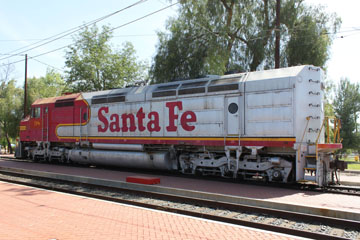
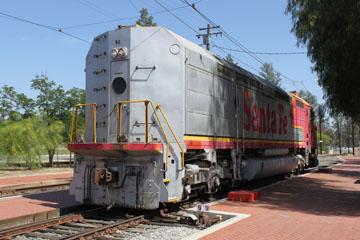
#98 was retired in late 1997 and donated to the OERM in January 1998.
You can see ATSF FP45 #92 on the Illinois Railway Museum Yard page of this website and #97 on the Museum of the American Railroad page.

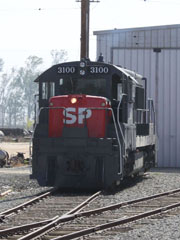
The U25B (nicknamed “U-Boat”) was the first commercially successful domestic diesel electric designed, built and sold by GE after it split from the Alco-GE partnership in 1953. The GE “Universal” Series began production in 1956 and about four hundred export units were sold (U4B, U6B, U9B, U9C, U12B, U12C, U18B, U18C & UD18B) before the U25B was offered in the US.
It was the highest horsepower four-axle diesel road locomotive in the US at the time of its introduction, and put GE on the road to becoming the top locomotive producer in the US.
#6800 was repainted in 1975 as Southern Pacific’s Bicentennial engine in celebration of the nation’s 200th birthday. Renumbered #3100 in 1979, it was retired in 1987. Sold for scrap, it was then bought by the museum in 1989. It still regularly pulls trains and switches at the museum.
The U25B has an FDL16 prime mover powering a GT598 generator to drive four GE-752 traction motors, one on each axle. Weighing 252,000 lbs and 60’ 2” long, it delivers starting tractive effort of 75,000 lbs at 30%, 64,000 lbs at 10.7 mph and has a top speed of 70 mph.
Four hundred and seventy-eight U25B units were built for US railroads by General Electric between 1959 and 1966. #3100 is one of sixty-eight bought by the Southern Pacific Railroad in 1963
(#7500–#7567).
Originally numbered #7508, this unit was
renumbered #6800 in 1975 after SP rebuilt it and one other U25B at its Sacramento Shops with
EMD electrical equipment, reclassifying them as U25BE units. However, the experiment was not considered a success and no other U25 units were converted.

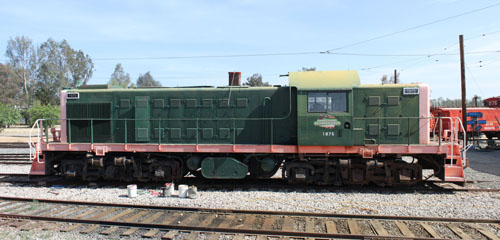
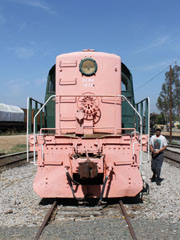
In October 1942, after Russia entered WWII as an allied power, American personnel took over the Trans-Iranian Railway supplying the USSR from Bandar Shahpur (now Bandar-e Emam Khomeyni) on the Persian Gulf. However, the USA Mikado 2-8-2s (#1000-#1199) were soon struggling with 1,000 ton “Aid-to-Russia” trains against high temperatures in the southern plains, and good water was scarce along the whole route.
Heavy grades made double-heading the norm and the many tunnels meant locomotive crews suffered in smoke and oil fumes. It was therefore decided to send diesel-electric locomotives to work the worst sections of the line and, to suit the
67-75lb rails, six-wheeled trucks were to be used. These would also increase tractive effort at lower speeds. The choice was the RSD-1, the first thirteen rebuilt from four axle Alco RS-1s (#8000-#8012).
You can see the first of these, TXIX RSD-1 #8000, on the Museum of the American Railroad page of this website.
Built in 1942 as #8018, OERM #1975 was one of of the first twenty-one, purpose-built RSD-1s (#8013-#8033). After WWII, it became DOT #015. It is 55’ 5¾” long and weighs 204,000 lbs. With an Alco 539T-6L prime mover powering a GE GT553C generator to drive four GE 731 traction motors, it delivers 34,000 lbs continuous tractive effort at 8 mph and had a top speed of 60 mph.
You can see other RSD-1s on the Tennessee Valley Rail Road Museum page of this website, the National Railroad Museum and Railroad Museum of Pennsylvania Yard pages.

The VO-1000 worked both yard and mainline services, and had a reasonably long service life. Right up until 1970, several railroads also tried repowering and remodelling their VO-1000s, although not always entirely successfully.
At least eight of the original VO-1000s have survived. You can see Western Railroad Company VO-1000 #1107 on the Museum of the American Railroad page of this website, CTN VO-1000 #32 on the B&O Museum Yard & Car Shop page and USN #7467 on the Tennessee Valley Rail Road Museum page.
Baldwin built five hundred and forty-eight
VO-1000s from 1939 to 1946, all for US railroads, forty for the US Navy. #8 was built as USN #2 in 1944 and went to Schumaker, OK. It became #8 at McAlister, OK, and later worked for the Port of Los Angeles Authority as #1.
#8 is 48’ 10” long and weighs 244,500 lbs. It has a 1,000 hp eight cylinder De Lavergne VO 6c prime mover, powering four Westinghouse WE362 traction motors, one on each axle. With a top speed of 60 mph, it delivers 34,000 lbs continuous tractive effort at 10.8 mph.

Delivered in September 1953 as #1543, this S-12 is one of fifty-six built for the Southern Pacific by Baldwin between 1951 and 1953, in addition to three delivered to the SP subsidiary, the Texas & New Orleans in 1953. Baldwin produced four hundred and fifty-two of these units between 1951 and 1956, all for US railroads.
#1543 worked in and around the Los Angeles
area for most of its operating life. The unit was later sold to Kerr McGee, the oil and gas operator based in Oklahoma City, OK, where it was renumbered #844.
Note the raised “washer/dryer” rear headlights, a feature of the last two orders of S-12s delivered to the SP (#1492-#1513 & #1539-#1550). The
S-12 has a De Lavergne 606A SC prime mover and Westinghouse WE480 generator powering four Westinghouse WE362 traction motors, one on each axle. Weighing 240,000 lbs and 48’ in length, it delivered 34,000 lbs tractive effort at 10.8 mph and had a top speed of 60 mph.
At least six S-12s are preserved at railroad museums, including Kerr McGee #845 shown next on this page.


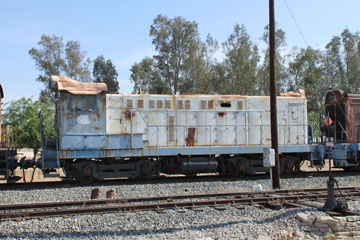
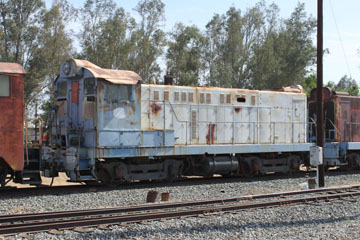
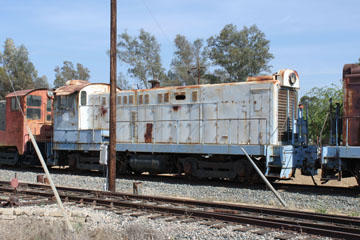
#1550 is a Baldwin built S-12 delivered to the Southern Pacific in 1953. Like #1543 shown earlier on this page, #1550 worked in and around the Los Angeles area all of its operating life. It too was later sold to Kerr McGee, the oil and gas operator based in Oklahoma City, OK, where it was renumbered #845.
Their powerful 6-cylinder prime mover meant
S-12s were known for their pulling power, but they were also considered temperamental. For technical details on the S-12, see the previous entry on this page for Kerr McGee #844.

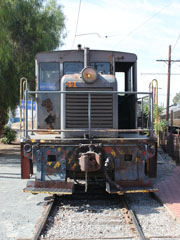
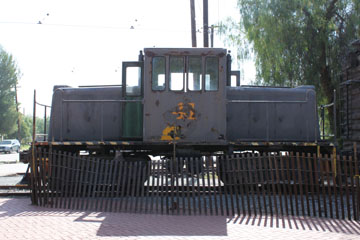
A 45-Ton switcher, #7441 was built by GE in 1942 for the US Air Force. It started work at Rock Island Arsenal on Arsenal Island in Illinois and was later transferred to the US Air Force Base in March, CA.
#7441 is powered by two Cummins NH150 diesel engines developing 300 hp. Each engine powers a generator which, in turn, powers a motor on each truck with side
rods connecting the axles.
You can see other GE
45-Ton switchers on the Mid-Continent Railway Museum page of this website and the Illinois Railway Museum Yard page.

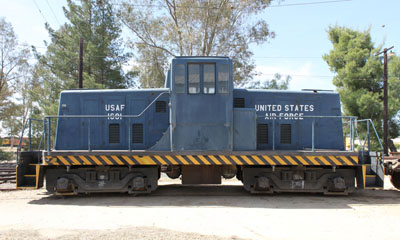
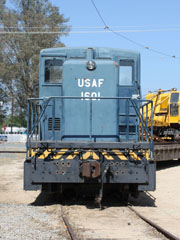
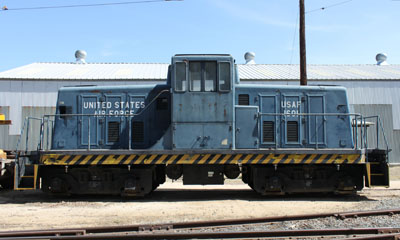
Built by GE in 1951 for the US Army, #1601 was later transferred to the US Air Force to work at Tinker Air Force Base, OK. It was then sold to Coast Grain, which was taken over by Scoular Grain, who then leased the facility, including #1601, to J D Heiskell.
This centre cab locomotive is powered by two Cummins L-6-1 diesel engines which deliver a total of 500 hp. GE built two hundred and sixty 80 ton switchers for US railroads between 1941 and 1974, as well as twenty for the US Air Force, one hundred and twenty-one for the Army, five for the Marine Corps and sixty-two for the Navy. A number are still in use at military facilities across the US.
As well as USAF #8580 next on this page, you can see ex-USAF #1694, now V&T D-1 running through Gold Hill, NV, on the Virginia & Truckee page of this website.


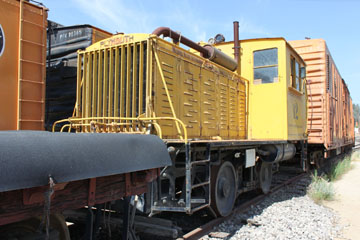
The Plymouth Locomotive Works in Plymouth, OH, built this ML-6 switcher for the US Army Corps of Engineers in 1941. It worked at the Quartermaster Depot in San Luis Obispo, CA, until declared surplus in 1946. Bought by Southern California Edison it served the company’s General Store facility in Alhambra, CA, until donated to the museum in 1974.
#12 is powered by a 175 hp six cylinder LeRoi gasoline engine. This is connected by a mechanical transmission to drive chains connected to the axles.

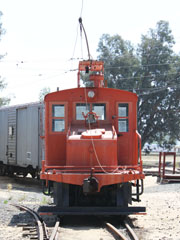
GE built this steeple cab electric locomotive in 1921 as a demonstrator. Designed to haul short freight trains, it was shipped to potential customers so they could test it in operation. In 1923, it was sold to the Hutchinson & Northern Railway, and ran there for forty-seven years.
The H&N had a two mile right of way near
Wichita, KS, built to serve a local salt mine and interchange with the Missouri Pacific in Hutchinson. The H&N replaced their electric locomotives with diesels in 1970, and donated #1 to the museum.
The original line is now part of the V&S Railway.

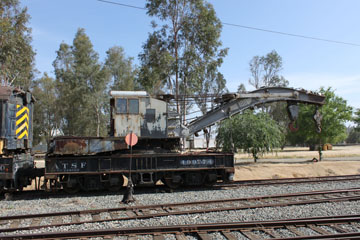

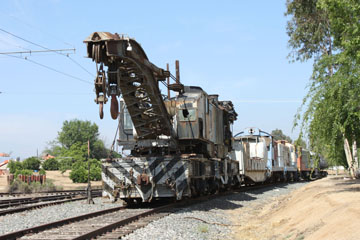
This originally steam powered 120 ton wrecking derrick was built for the AT&SF as #99774 by Industrial Works, Bay City, MI, in 1909. It was later renumbered #199774 and, in 1959, was converted to diesel power. Retired in 1971, the diesel equipment was removed and installed in ATSF #199787. It was donated to the museum the same year without the operating mechanism and the rear portion of the cab.
In 1976, the museum acquired a far more complete wrecking derrick, Southern Pacific
MW-7090 shown next on this page.
Because of its
incomplete disposition, the museum offered #199774 for free in 1998 to anyone who would take it off the museum property. When I visited, there had still been no takers.
Below, #199774 is coupled to SP Wrecking Derrick MW-7090.
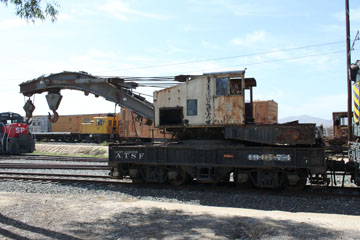
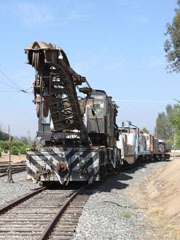
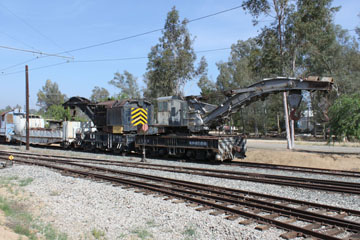

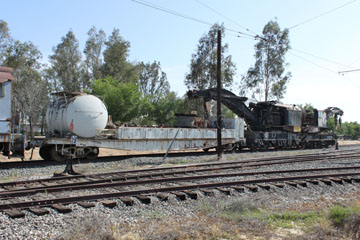

The Industrial Works also built this 120 ton steam powered derrick for the Central Pacific in 1912 as #615. It became Southern Pacific MW-7024, then, in 1931, MW-7090. It was bought by the museum in 1976 with SP Relief Tender #7091.
You can see more Industrial Works cranes on the Railroad Museum of Pennsylvania Yard page of this website, the B&O Museum Yard, Virginia Museum of Transportation, Nevada Northern Railroad Museum, Spencer S. & Hope Fox Eccles Railroad Center, Lake Superior Railroad Museum and Gold Coast Railroad Museum pages.
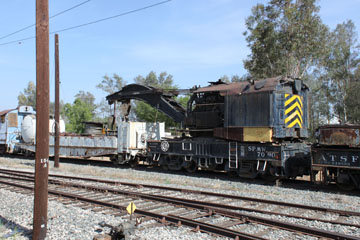
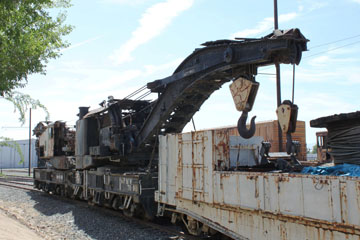

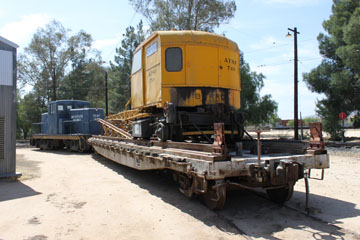
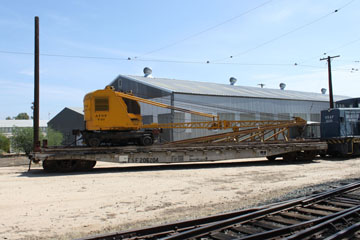
The boom can be fitted with different tools depending on the assignment, from a hook to an electromagnet. #749 can also load and unload itself from the flat car by picking up the track ramp that sits on the deck, lowering it into place on the rails and driving down onto the rails. The lifting cable is attached to the flat car deck and the crane winches itself back up the ramp .
You can see other Burro cranes on the Gold Coast Railroad Museum page of this website, the Savannah Roundhouse Museum page and the Baltimore & Ohio Railroad Museum Yard page.
Burro Crane #749 was built by by the Cullen-Friestedt Co., of Chicago, IL, for the AT&SF in 1951. The “Burro” was named after the hardy old West pack animal, a Spanish breed of donkey.
#749 worked into the 1990s when it was donated
to the museum with the special flat car used to move it from job to job. Note the extra set of
wheels on the outside of the crane, which engage with the rails to give greater stability when operating from the deck. Self-propelled, #749
could tow a flat car or other equipment needed to work.

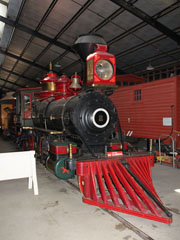
Nevada Central #2 was the first locomotive to join the “Grizzly Flats Railroad” in 1938.
The Grizzly Flats began in Ward and Betty Kimball’s San Gabriel, CA, back yard. Ward,
who was then an animator for Walt Disney Studios and avid railroad enthusiast, decided to buy the last passenger coach from Southern Pacific’s narrow gauge subsidiary, the Carson & Colorado Railroad.
With a friend’s
prompting, he then bought Mogul (2-6-0) type locomotive #2, once named “Sidney Dillon”, which had operated on the Nevada Central since 1881.
The narrow gauge Nevada Central was completed in 1880 to connect the silver
mining district of Austin, NV, with the Southern Pacific at Battle Mountain.
Although major silver production soon ended in about 1887, the railroad struggled on.

By the 1930s, however, most of the mines had closed and the NCRR passed into receivership for the last time in 1938.
You can see another surviving Nevada Central locomotive ex-Northern Pacific Coast #12 on the California State Railroad Museum page of this website.
After Coach #5 and the vintage steam
locomotive were installed on a short section of track in the Kimballs’ San Gabriel orange grove, friends and family helped with the restoration effort.
Ward renamed #2 “Emma Nevada” after a famous opera star of the late 1800s.
In the following years,
the track was extended,
a depot, caboose, cattle car and an 0-4-2T steam locomotive that once ran in Hawaii were added. The second locomotive was named “Chloe” after the Kimballs’ youngest daughter (the “Chloe” is shown next on this
page).
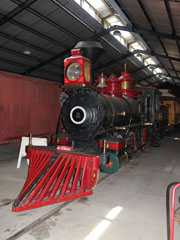

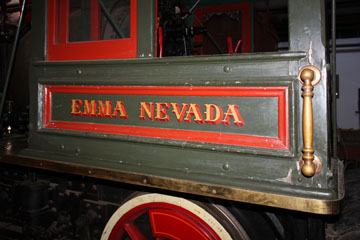
#2 was built by Burnham, Parry, Williams & Co., an early incarnation of the Baldwin Locomotive Works. The photos above and right show how the Kimballs made it look more like a locomotive from the 1860s than one built in 1881. It last steamed regularly in 1951, when it was side-lined with mechanical issues, but ran again once in 1985 in a race with Tom Scherman’s “Iron Man”.
A coal burner, #2 weighs 44,000 lbs, 37,000 lbs on its 41” drivers. It has 13” x 18” drivers and operated at a boiler pressure of 100 psi delivering 6,350 lbs tractive effort.

#2 was built by Baldwin
in 1883 for the Waimanolo Sugar Co., in Waimanolo, HI, as “Pokaa”.
You can see another ex-Waimanolo locomotive, #3 “Olomana”, on the Railroad Museum of Pennsylvania Yard page of this website.
This was the second locomotive bought for the “Grizzly Flats” in 1948. #2 was named “Chloe” after the Kimballs’ daughter. It weighs 18,750 lbs, 14,000 lbs on its 24” drivers. With 7” x 10” cylinders, it operated at a boiler pressure of 150 psi delivering 3,125 lbs tractive effort.
Ward donated the “Emma Nevada”, Coach #5 and most of the rolling stock to the museum in 1992. The “Chloe”, a sightseeing car and two gondolas stayed at the Kimballs. Ward died in 2002, but the family continued to operate #2 until 2006 when it was donated to the museum.


This gas hydraulic switcher was built by the Plymouth Locomotive Works in Plymouth, OH, for the Nevada Central and was bought by the Kimballs for the “Grizzly Flat Railroad” after the Nevada Central ceased operations in 1938.
Over 7,500 locomotives were built in Plymouth starting in 1910 under
the J. D. Fate Company, then in 1919 as Fate-Root-Heath and becoming Plymouth Locomotive Works in the late 1950s. They were generally under 25 ton gasoline burners designed for industrial use. The last engine came off the factory line in 1999.

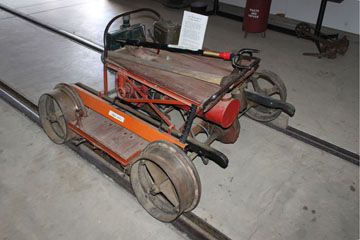
Built some time in the 1920s by Fairmont Railway Motors, the Rio Grande Southern operated this motor car right up until abandonment in 1951. It was then moved to Knotts Berry Farm in Buena Park, CA, along with other RGS equipment and, apparently, personnel to form the nucleus of the Ghost Town & Calico Railroad running around the perimeter of the park. Service started on 12th January 1952, and the GT&CR still operates to this day with the restored RGS equipment.
The motor car was donated to the museum by Knotts Berry Farm Train Shop owner, Evan Middleton, and has been restored to operating condition.
Hardly glamorous by rail fan standards, motor cars like this one and their predecessors, hand pumped handcars, were nevertheless an important part of railroad operations. They were used by track inspectors and railroad work crews to move quickly to and from work sites with their tools, and could be easily lifted clear of the tracks to allow regular trains to pass (note the well worn handles in the photo on the lower left). Uses also included signal and telegraph maintenance, and fire prevention.


